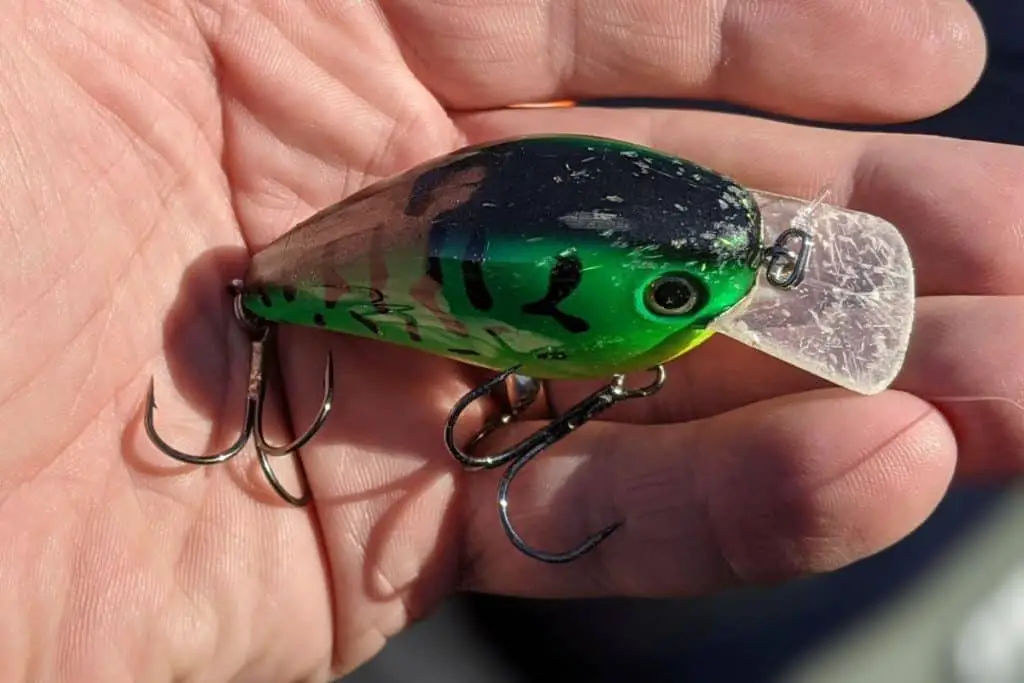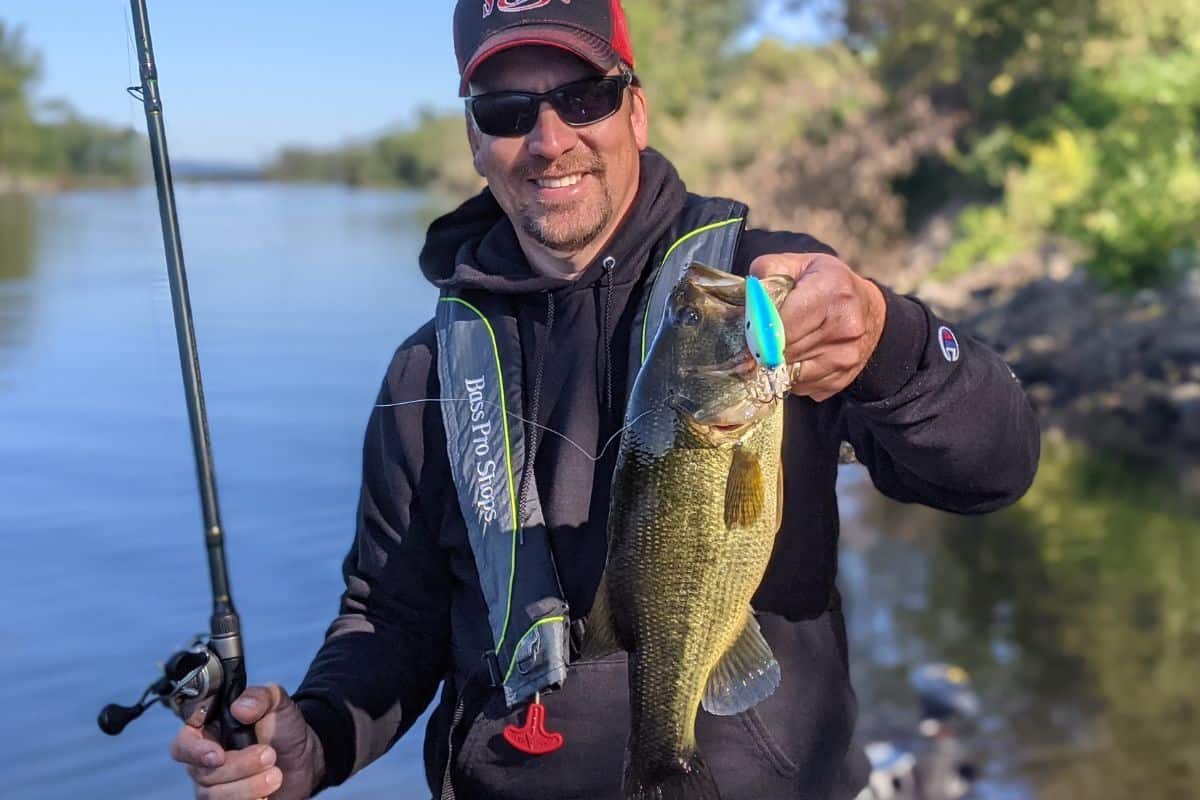The squarebill crankbait is in a class all its own. This versatile lure is one that every angler should keep at the ready.
Anglers should use squarebill crankbaits when fishing water up to 9 ft in depth that has lots of cover or structure changes. It does exceptionally well when banging and bouncing into hard objects.
A squarebill expert once told me that anyplace you would throw a spinnerbait is a good place to throw a squarebill. I have taken that mindset to heart and it is true.
Knowing What a Squarebill Crankbait Does Well
When anglers have an understanding of what a squarebill crankbait excels at, it makes deciphering when to use one easier.
This lure excels at triggering reaction bites.
Think about this type of bite as forcing the bass to react when it’s not in a feeding mindset. The sudden and erratic movements drive them to make an instinctual decision.
I like to use this example. Imagine someone flicking their hands in your face. You are most likely going to react to this. You may even swat the person’s hands away. Bass have two choices – eat the lure or flee in aggravation. We hope that they react by attacking the squarebill.
The Type of Cover and Structure that Causes Reaction Strikes
A squarebill crankbait is designed to smash off of stuff.
This can be submerged wood, rocks, dock posts, sea walls, boulders, or anything else that can cause the lure to deflect.
What we are looking for as anglers is the sudden erratic movement.
For new anglers who have not done this, it can be a little unnerving. When we first learn to bass fish each of us is careful not to get stuck or hung up. This type of presentation goes against those instincts we developed when first learning to fish.
The bill of the crankbait does an amazing job of keeping those hooks clear of obstacles. And if there is something you’re not sure it can handle, pause, let the squarebill float up, and then reel the lure over the object in question.
My favorite lures are the ones that are beat and battered. These beauties are reminders of how to fish this lure and where it does its best work.
(Here is an article on what triggers bass to bite.)

Paralleling Cover and Structure With a Squarebill Crankbait
This is the most effective angle to take when using a squarebill along cover and structure.
Make long casts parallel with the shoreline and bring it back at a depth that hits anything you can. One of my favorite places to use squarebills is along rip-rap embankments. These lures hunt up largemouth and smallmouth relentlessly.
Adjusting Lure Size Based on the Results
Even though we are technically fishing “shallow” with a squarebill. It is important to remember these lures are designed with different target depths and body profiles.
The below table will clearly outline the Strike King KVD series of squarebills.
| Lure Model | Dive-to Depth (ft) | Lure Body Lenth (in) | Weight (oz) |
| KVD 1.0 | 2-4′ | 2″ | 3/8oz |
| KVD 1.5 | 3-6′ | 2 1/2″ | 7/16oz |
| KVD 2.5 | 3-5′ | 2 3/4″ | 5/8oz |
| KVD 4.0 | 6′ | 4″ | 5/8oz |
| KVD 8.0 | 6-9′ | 4 1/2″ | 1 1/2oz |
As you can see, these lures will target depths greater than many anglers realize.
Another important factor to keep in mind while fishing these lures is the profile size.
When fishing the upper Mississippi River recently, I experienced a clear example of what a different lure body profile can mean for a day on the water.
I was using the KVD 1.5 and catching a few fish that were on the smaller size. I switched to the KVD 2.5 and immediately started catching more bass of much better quality. And as you can see from the above table, the target depth for these lures is the same, but the 2.5 offers a larger profile.
The Retrieve for Fishing Squarebill Crankbaits
99% of the time I am burning this lure as fast as I can.
Literally.
I put the rod handle in my side and turn the reel handle as fast as I can with a start-stop type of retrieve.
This does two things for bass anglers.
First, it causes powerful deflections off of cover and structure. Second, it still creates those reaction bites when the lure is working through open water and not hitting anything.
It can be an exhausting way to fish, but it works and works well.
If you have not burned a squarebill crankbait before, it is going to feel strange at first. You may even think I’m crazy. Trust me. It is the best way to fish this lure.
You can, of course, crawl the lure through heavy cover and it still performs, but it really shines when there is some speed behind the retrieve.
Proper Equipment for Squarebill Crankbait Fishing
The rod is critical when bringing a lure back this fast.
If possible, have a rod designed for crankbait fishing. These will be either fiberglass or composite. These rods are not solid graphite and have less sensitivity and more parabolic action than solid graphite rods.
You may be thinking less sensitivity is bad. Not when using crankbaits.
Treble hooks “grab” more than they penetrate. These hooks are notoriously easy for bass to throw. If crankbait anglers use a rod that is too sensitive, we instinctively set the hook too quickly and yank the lure right away from them.
A good crankbait rod with nice parabolic action will absorb the strike and maintain pressure without ripping the lure free. The nice thing is quality crankbait rods are not that expensive. I really like the David Fritts signature rods from Lew’s. At the time of this writing, you can buy one for $79.
As far as a reel, when using deep divers, I want the lowest gear ratio I can get. With squarebills, I am OK with using a high-speed reel because of the burning retrieve. It is impossible for us to move that lure quicker than the bass can swim. If they want it, they are going to get it.
Since the best presentation involves smashing this lure into everything I can, my line choice will be fluorocarbon anywhere from the 15-25 pound test range.
Good luck out there and make sure to encourage someone today. You never know how you may change their life forever.
Isaiah 6:8

